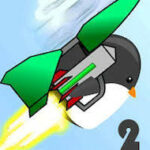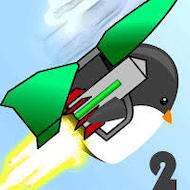Learn To Fly 2 invites players to embark on an exciting journey of mastering flight through trial, error, and strategic upgrades. The game centers around launching a penguin into the sky and enhancing every aspect of its flight mechanics, from launch power to glide ability. Each flight is a test of timing and upgrade management, as you strive to push your character farther than before. The game’s straightforward interface masks a deep progression system, rewarding players who experiment with launch angles, power, and equipment to optimize their results. Whether aiming for maximum distance or attempting specialized challenges, this game balances simplicity with engaging gameplay loops that encourage continuous improvement.
How to Maximize Flight Distance
The core gameplay in Learn To Fly 2 revolves around achieving the greatest possible flight distance, which is not only about launching but managing flight dynamics throughout the entire arc. The launch angle and power settings are the initial variables that dictate how far and high the penguin will fly, but post-launch controls and upgrades play a significant role in extending airtime.
- Adjust Launch Angle: The angle of launch determines trajectory; angles between 30 and 60 degrees generally provide the best balance between height and horizontal distance. Experimentation is key since wind conditions and upgrades can influence the ideal angle.
- Control Launch Power: Increasing the power at launch boosts speed, which can help cover longer distances but may cause the penguin to ascend too steeply, leading to a quicker descent. Finding the right balance is essential.
- Use Boosters: Activating rocket boosters mid-flight is a vital mechanic. These boosters give an additional speed burst and help counteract gravity, extending flight distance significantly when timed correctly.
- Mid-Air Adjustments: Steering the penguin in the air affects aerodynamics and flight path. Proper maneuvering can help catch air currents or glide longer.
Mastering these launch and in-flight techniques requires practice, but with each successful flight, players unlock access to better upgrades and new areas, encouraging continuous play and skill development.
Upgrades and Customization
Progression in Learn To Fly 2 is heavily dependent on purchasing and upgrading various gear and equipment. Each category of upgrades influences specific flight parameters and allows players to tailor their approach to flying.
- Rocket Power: Boosting rocket strength increases thrust for both the initial launch and mid-air speed bursts, making it easier to reach higher altitudes and longer distances.
- Glide Ability: Enhances the penguin’s ability to stay airborne by improving aerodynamics and reducing descent speed. This upgrade is crucial for maximizing airtime.
- Weight Reduction: Decreasing weight makes the penguin more agile and capable of reaching greater heights, although it may reduce stability, so balance is important.
- Parachutes and Gear: Equipping parachutes allows for smoother landings and more control during descent phases, helping avoid crash penalties and enabling recovery for additional boosts.
- Flight Accessories: Additional tools like wings or jetpacks may be unlocked later, introducing new gameplay mechanics and strategies.
Smart investment in these upgrades combined with skillful flying makes it possible to break distance records and unlock new content within the game.
Game Modes and Progression
Learn To Fly 2 features multiple gameplay modes that keep the experience varied and rewarding. Beyond the primary goal of achieving maximum distance, specialized challenges test players’ ability to control their flights under different conditions.
- Distance Challenges: Players must reach or exceed certain distances to unlock the next stages or earn rewards.
- Target Practice: Aim to hit specific mid-air or ground targets for bonus points and special unlocks, requiring precision alongside power.
- Time Trials: Complete flights within designated time limits to add a layer of urgency and strategic timing to gameplay.
- Survival Flights: Avoid obstacles and survive challenging weather conditions, demanding both quick reflexes and smart upgrade use.
These modes diversify gameplay, providing opportunities to refine skills and explore different aspects of the flight mechanics.
Learn To Fly 2 blends intuitive controls with layered strategic upgrades, delivering a game experience that rewards curiosity and persistence. Its combination of physics-based flight and customizable upgrades makes it appealing for players seeking continuous challenge and progression in a casual setting.













 Fullscreen
Fullscreen






